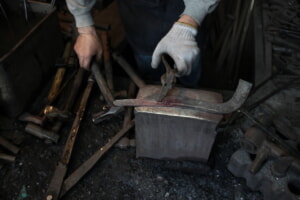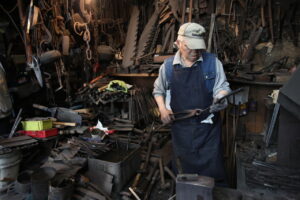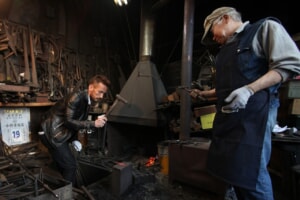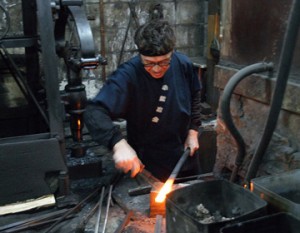Craftsman making tools for tapping lacquer
In Tsugaru, there is a lacquer craft called ”Tsugaru nuri”. Needless to say, you need lacquer to make ”Tsugaru nuri”. The first step is to collect lacquer by tapping. A tool is used to create a notch in the brunk of the lacquer tree to collect the sap that oozes out. The sap is called ”arami”.
Fumitoshi Nakahata, a blacksmith in Takkomachi City, Aomori Prefecture makes the tools that are used for tapping. There are various tools, including a sickle to peel the bark off the tree, a plane to scratch the trunk, and a spatula to scoop off the sap. Not only does Nakahata make all these tools, what’s amazing is that he adjusts every single tool depending on who the tapper is. He finely adjusts the width and curve of the blade depending on the tapper’s habits or request. It is a time consuming task that also requires highly refined techniques.

Limited to three tools a day
As soon as he graduated from school, he learned the trade from his father, Chojiro, and he has been in this business since. In 1995, he was selected to be the Selected Conservationary Technology Holder of the country. He showed us how he does blacksmith work. He manipulates the bellow with his left hand, adjust the fire and heats the sickle. The way he take it out and hits it, makes him look exactly like a blacksmith of the old days. Again and again, he repeats the task to make subtle adjustments. Sometimes he even makes a few millimeter adjustment. “The most difficult one to make is the planar which makes a groove in the tree.” he says. Curvature of the tip is important and requires careful work. Nakahata says “I can only make three a day.” Every scraper has his own demands so they cannot be made with a machine because the form are not uniform. This is precisely the tool that are made when the craftsman meet face to face with the users.

Creator that users trust
For this reason, the tools can not be mass produced. “”I should make tools if I have any free time.”” he tells himself, but the orders seems to be different every year. The thickness of the tree also seems to influence the orders. Surprisingly, the difference with the orders are very minute. “”Last year I requested 4.3 millimeters, but since the tree is different this year, can you make it 4.1 millimeters?””, a request of only 0.2 millimeter difference. First and foremost, this is a result of how much they entrust Nakahata. Nakahata commented about his work, “”It’s good because I’m still able to make tools people want to use.”” I make tools which people like to use.
People come to Nakahata wanting to learn the trade, but the number is very small. Some even say that Nakahata is the only person who can make genuine lacquer tapping tools. “”I want to pass on the technology and skills so that tappers aren’t inconvenienced.”” Nakahata told us. Takkomachi is committed to passing on the technology by using the “”Local Revitalization Cooperative System”” which the country promotes as part of the local revitalization program, to recruit trainees.





